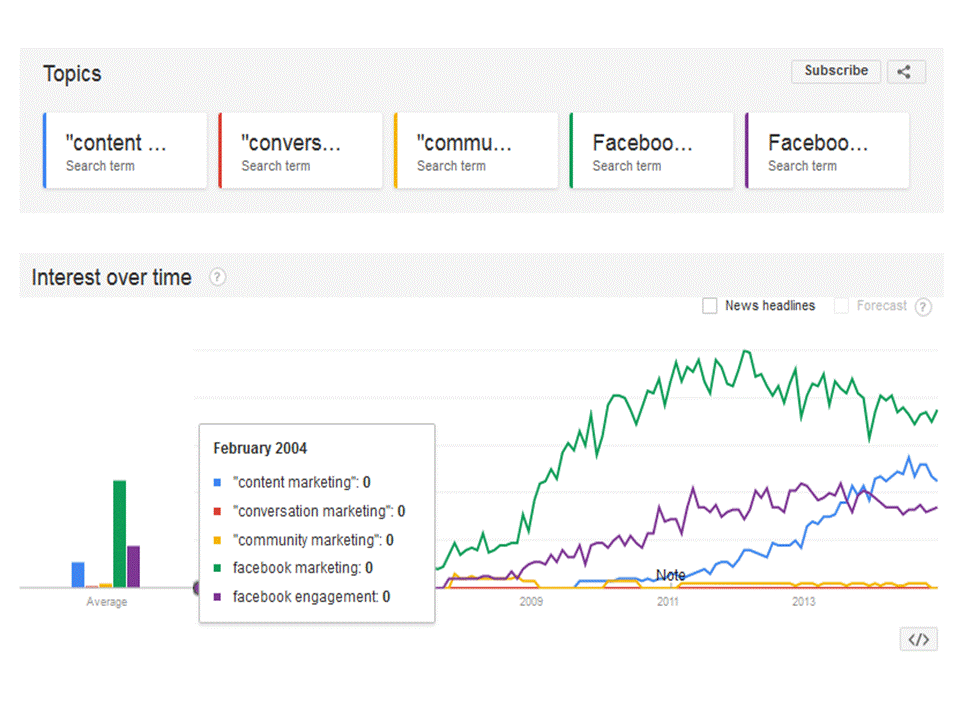What next after content marketing?
(Way) back in 2008 I wrote a rather lengthy paper on the theory of social media. Interestingly, it has become the blogging equivalent of Pink Floyd’s Dark Side of the Moon in that it has hung around in my list of current popular posts ever since. Within this I suggested that the key assets for operating in the social media space were content, conversation and community. I also proposed that we were likely to move through these in sequence: content being the easiest thing to deal with, followed by conversation and ending up with community.
Well – we certainly have embraced the content thing. So, if my theory holds – could the next big thing be conversation marketing?
 So I turned to Google Trends. What this showed (see blue line in the diagram above) is the extent to which content marketing has exploded over the last two years (albeit four years after I proposed it in my paper). Interestingly, this is plotted against Facebook marketing (green), which we can see peaked as a subject of interest in late 2011 and Facebook engagement (purple) which peaked a little later. We now talk more about content marketing than we do about Facebook engagement (at last).
So I turned to Google Trends. What this showed (see blue line in the diagram above) is the extent to which content marketing has exploded over the last two years (albeit four years after I proposed it in my paper). Interestingly, this is plotted against Facebook marketing (green), which we can see peaked as a subject of interest in late 2011 and Facebook engagement (purple) which peaked a little later. We now talk more about content marketing than we do about Facebook engagement (at last).
As an aside, the content marketing that brands are doing, doesn’t really correspond to the type of content marketing I envisaged. I was proposing an approach to content that was about creating a network of information threads within a brand’s relevant digital space, not simply ramming the channels with stuff. However, I think we will come around to my way of thinking in time – possibly as brands become more conversational, and thus more in tune with what content (information) consumers want, as distinct from the content brands want them to have.
However, Google Trends didn’t really turn up any evidence to suggest that conversation or community might be the next things. In its (or my) defence, this is probably because we haven’t yet created ‘the word’ for what conversation or community based marketing might be. Key to the birth of any new thing is christening it with a name. So I guess we have to look elsewhere for evidence. Here I would return to the post I wrote a few week ago about Edleman’s Brandshare Report. Here we see very clear evidence that consumers want to have conversations with brands, albeit conversations that start with the issues consumers want a response to, rather than the issues brands might want to have conversations about.
Content marketing, even when you do it right, is actually very easy. It doesn’t involve changing the model of marketing or actually involving the consumer too much. That is why I suggested content would be the first big thing to arrive (once brands had got over their initial obsession with Facebook and Twitter). Conversation marketing is harder because it involves seeding an element of control, if only in terms of letting the consumer decide what conversations they want to have. It involves changing the configuration of marketing resources with a shift towards investment in people and processes, rather than agencies and media. It also involves recognising that you can’t have a conversation with everyone all at once – and thus you only create positive ROI by extracting much higher value from a much more limited ‘reach’ (subject of the e-book I wrote last year). In fact it involves abandoning the idea of reach as a sensible metric altogether. It also corresponds to what I am calling the concept of ‘Hot Marketing’ – the creation of genuinely valuable (hot) relationships, albeit much fewer of them at any one moment in time than when were creating (cold) relationships with entire audiences.
This additional level of difficulty is the reason I think it is going to be a couple of years before brands really get to the place where they understand how to create value from conversation. I also think brands will need to get over the current obsession with ‘brandfill’ content strategies before they will have the operational space to move onwards. I guess this puts the concept of community marketing back to at least five years’ out. This is a shame, especially since I have spent most of this year banging on about forms of community! However, effective communities involve creating a much greater level of shared interest and collaboration between brands and consumers than most marketing folk are prepared to countenance. In fact, we will probably only get to the community phase by reinventing the concept of marketing as we know it.
Looking back at my 2008 piece, I am still pretty happy with its core conclusions. I would stand by everything I said within it and I think what I predicted is basically panning out – although perhaps not as quickly as I thought it might. But there again, I am aware that one of the features of any revolution is that one tends to overestimate its impact in the short term, but underestimate its impact in the long term.
